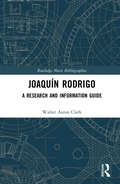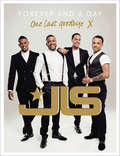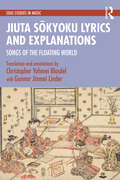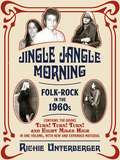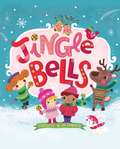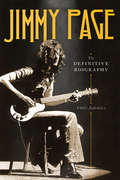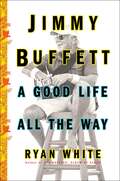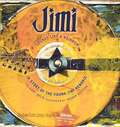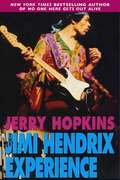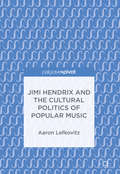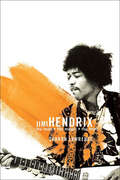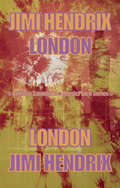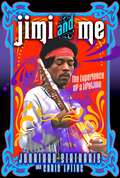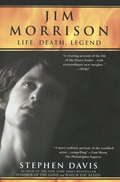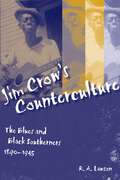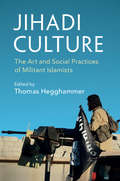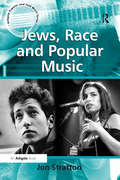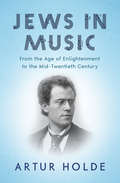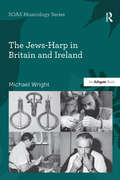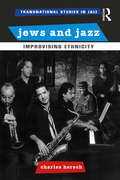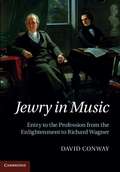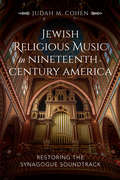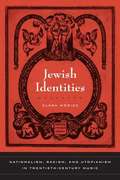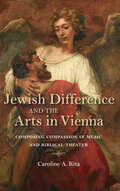- Table View
- List View
Joaquín Rodrigo: A Research and Information Guide (Routledge Music Bibliographies)
by Walter Aaron ClarkJoaquín Rodrigo: A Research and Information Guide catalogues and summarizes the musical works and related literature of Joaquín Rodrigo (1901–99), perhaps the most important Spanish composer of concert music in the second half of the twentieth century. The guide provides annotated bibliographic entries for both primary and secondary sources, detailing several guitar concertos, concertos for flute, violin, harp, cello, and piano, as well as symphonic pieces, piano solos, chamber music, and choral and stage works. Rodrigo’s reputation rests on the Concierto de Aranjuez for guitar and orchestra and its expressive middle movement, which inspired jazz arrangements by Miles Davis and Chick Corea in the 1960s and continues to appear in film scores even eighty years after its composition. A major reference tool for all those interested in the prolific Rodrigo and his music—featuring a chronology of the composer’s life and robust indices that enable researchers to easily locate sources by author, composition, or subject—Joaquín Rodrigo: A Research and Information Guide is a valuable resource for students and researchers alike.
JLS: Forever and a Day
by JLSSince forming in 2007, JLS have achieved everything they'd hoped for and more. From four smash-hit albums and five number one singles, to BRIT and MOBO awards and sell-out tours, Oritsé, Marvin, JB, and Aston have proved themselves as one of Britain's biggest boybands ever. But all good things come to an end and in this, their last ever official book together, the boys share their favourite memories with the people they love most: their fans.Inside, they reflect on everything they've experienced in the last six years, as a band and in their own personal lives, while sharing exclusive photos and the secrets they've kept. Find out how they feel about juggling family and finding love with life on the road and recording in the studio; how special it feels to step out on stage in front of thousands of fans and why choosing to part from the best friends they could have ever found was the hardest decision of all.The highs, the lows; the good times and bad, this is JLS like you've never seen them before. Older, wiser and hotter than ever, this is their final farewell and a treasured keepsake for years to come.
Jiuta Sōkyoku Lyrics and Explanations: Songs of the Floating World (ISSN)
by Christopher Yohmei Blasdel Gunnar Jinmei LinderJiuta Sōkyoku Lyrics and Explanations is a compendium of seventy-three representative songs from the well-known genre of traditional Japanese Edo-period sankyoku ensemble music.Including extensive annotations along with commentaries and notes on their musical and performative aspects, the collection begins with an overview which traces the history of the jiuta sōkyoku genre and the various socio-political influences at work in its formation. The translations and analyses are followed by a substantive glossary and bibliography, allowing for a deeper understanding of both the literary and musical aspects of jiuta sōkyoku compositions.Jiuta Sōkyoku Lyrics and Explanations is a comprehensive anthology that will be of great interest to researchers, including ethnomusicologists, Japanese studies scholars and poetry lovers who are fascinated with the literary and musical impact of the Edo period.
Jingle Jangle Morning
by Richie UnterbergerJingle Jangle Morning is the story of how folk and rock merged in the 1960s to create folk-rock, injecting social consciousness and poetic lyricism into popular music to scale heights that neither folk nor rock could have reached without blending. It draws on more than 100 first-hand interviews with key musicians, producers, promoters, and journalists, from stars like Roger McGuinn of the Byrds, Donovan, John Sebastian of the Lovin' Spoonful, and Judy Collins to behind-the-scenes producers and cult artists. Starting with the folk revival of the early 1960s, it covers the folk-rock movement from the first stars to electrify folk (especially the Byrds and Bob Dylan) to stars like Buffalo Springfield, Joni Mitchell, and Crosby, Stills, Nash & Young, as well as underrated greats (like Richard & Mimi Fariña, Fred Neil, Tim Buckley, and Nick Drake to nearly unknown cult artists. Previously published in two separate volumes as Turn! Turn! Turn! and Eight Miles High, this combines those books into one, adding 15,000 words of updates and new material. It also adds a 75,000-word mini-book with in-depth descriptions of nearly 200 folk-rock recordings from the era, which together would comprise the ideal 1960s folk-rock box set. All branches of the decade's folk-rock are covered, from early electric folk-rock, protest folk-rock, and folk-rock-psychedelia to singer-songwriters, country-rock, and the distinctively British form of folk-rock.
Jingle Bells
by Jill Howarth<p>Introduce babies to this classic Christmas carol, complete with bells that really jingle!<p> <p>Sing along to the merriest classic Christmas song as everyone dashes through the snow to get to a tree-lighting ceremony! Be sure to jingle the bells to make the song come to life!<p>
Jimmy Page: The Definitive Biography
by Chris SalewiczAn in-depth biography of Led Zeppelin guitarist Jimmy Page by the acclaimed biographer of Bob Marley and Joe Strummer, based upon the author's extensive research and interviewsThe original enigmatic rock star, Jimmy Page is a mass of contradictions. A towering presence in the guitar world and one of the most revered rock guitarists of all time, in private he is reclusive and mysterious, retiring and given to esoteric interests. Over the decades he has exchanged few words to the press given the level of his fame, and an abiding interest in the demonic and supernatural has only made the myth more potent.But in the midst of this maelstrom, who was Jimmy Page? Rock journalist Chris Salewicz has conducted numerous interviews with Page over the years and has created the first portrait of the guitarist that can be called definitive, penetrating the shadows that surround him to reveal the fascinating man who dwells within the rock legend.
Jimmy Buffett: A Good Life All the Way
by Ryan WhiteA candid, compelling, and rollicking portrait of the legendary pirate captain of Margaritaville—Jimmy Buffett.In Jimmy Buffett: A Good Life All the Way, acclaimed music critic Ryan White has crafted the definitive account of Buffett&’s rise from singing songs for beer to his becoming a tropical icon and inspiration behind the Margaritaville industrial complex, a vast network of merchandise, chain restaurants, resorts, and lifestyle products all inspired by his sunny but disillusioned hit &“Margaritaville.&” Filled with interviews from friends, musicians, Coral Reefer Band members, and business partners who were there, this book is a top-down joyride with plenty of side trips and meanderings from Mobile and Pascagoula to New Orleans, Key West, down into the islands aboard the Euphoria and the Euphoria II, and into the studios and onto the stages where the foundation of Buffett&’s reputation was laid. Buffett wasn&’t always the pied piper of beaches, bars, and laid-back living. Born on the Gulf Coast, the son of a son of a sailing ship captain, Buffett scuffed around New Orleans in the late sixties, flunked out of Nashville (and a marriage) in 1971, and found refuge among the artists, dopers, shrimpers, and genuine characters who&’d collected at the end of the road in Key West. And it was there, in those waning outlaw days at the last American exit, where Buffett, like Hemingway before him, found his voice and eventually brought to life the song that would launch Parrot Head nation. And just where is Margaritaville? It&’s wherever it&’s five o&’clock; it&’s wherever there&’s a breeze and salt in the air; and it&’s wherever Buffett set his bare feet, smiled, and sang his songs.
Jimi Sounds Like a Rainbow: A Story Of The Young Jimi Hendrix
by Gary GolioJimi Hendrix was many things: a superstar, a rebel, a hero, an innovator. But first, he was a boy named Jimmy who loved to draw and paint and listen to records. A boy who played air guitar with a broomstick and longed for a real guitar of his own. A boy who asked himself a question: Could someone paint pictures with sound? This a story of a talented child who learns to see, hear, and interpret the world around him in his own unique way. It is also a story of a determined kid with a vision, who worked hard to become a devoted and masterful artist. Jimi Hendrix--a groundbreaking performer whose music shook the very foundations of rock 'n' roll.
The Jimi Hendrix Experience
by Jerry HopkinsIt's been over forty years since the tragic death of Jimi Hendrix, yet his popularity is undiminished and his place as the preeminent electric guitarist of the ages is still unrivaled. In The Jimi Hendrix Experience, bestselling author and rock aficionado Jerry Hopkins delves into the legendary life and career of the greatest man to ever pick up a guitar. With a consistent mix of greatness and madness, learn why the man who only released three studio albums during his life could forever transform not only music, but also a generation. While he'll always be remembered for his incredible performance at Woodstock in 1969, Hopkins shows the true side of Hendrix: from his early childhood and the beginning of his career to his early death and the controversial battle of control over his estate that still wages on. With incredible photographs depicting Hendrix's rise to the top, The Jimi Hendrix Experience is the ultimate biography of the "Voodoo Chile." Hendrix's legacy and music will live on for generations to be enjoyed by and to live on with fans of all ages. And now, thanks to Hopkins, his life can be relived through this incredible biography.
Jimi Hendrix and the Cultural Politics of Popular Music
by Aaron LefkovitzThis book, on Jimi Hendrix’s life, times, visual-cultural prominence, and popular music, with a particular emphasis on Hendrix’s relationships to the cultural politics of race, gender, sexuality, ethnicity, class, and nation. Hendrix, an itinerant “Gypsy” and “Voodoo child” whose racialized “freak” visual image continues to internationally circulate, exploited the exoticism of his race, gender, and sexuality and Gypsy and Voodoo transnational political cultures and religion. Aaron E. Lefkovitz argues that Hendrix can be located in a legacy of black-transnational popular musicians, from Chuck Berry to the hip hop duo Outkast, confirming while subverting established white supremacist and hetero-normative codes and conventions. Focusing on Hendrix’s transnational biography and centrality to US and international visual cultural and popular music histories, this book links Hendrix to traditions of blackface minstrelsy, international freak show spectacles, black popular music’s global circulation, and visual-cultural racial, gender, and sexual stereotypes, while noting Hendrix’s place in 1960s countercultural, US-exceptionalist, cultural Cold War, and rock histories.
Jimi Hendrix: The Man, The Music, The Truth
by Sharon LawrenceThe genius we never understood. . . . The man we never knew. . . . The truth we never heard. . . . The music we never forgot. . . . A revealing portrait of a legend by a close and trusted friend.
Jimi Hendrix
by William SaundersDescribing how the city of London helped transform a little-known musician named Jimmy James into rock legend Jimi Hendrix, this revealing volume details how Hendrix helped transform London into a dynamo of popular music and social rebellion. The book examines Hendrix's impact on London's leading musicians-including the Beatles, the Rolling Stones, and Eric Clapton-and follows Hendrix as he acquires a savvy manager, a tight band, and a forgiving girlfriend and launches himself into a breakneck career that whisked him from dingy clubs to Woodstock and recording and television studios. Each chapter introduces unforgettable characters and takes readers on a trip through the psychedelic era, concluding with Hendrix's tragic death in a London apartment. It explores the public as well as the private man, capturing the contrast between the wild showman on stage and the unassuming guy behind the scenes.
Jimi and Me: The Experience of a Lifetime
by Jonathan StathakisA young screenwriter is invited to collaborate with Jimi Hendrix on a film, resulting in the wildest eighteen months of his life and coinciding with the tumultuous final months of Hendrix&’s life.In 1969, a twenty-something screenwriter with one movie credit to his name is approached by Jimi&’s management after the legendary guitarist saw the obscure indie film in London and had the idea to collaborate on a project of his own. Jonathan Stathakis had no idea how thrilling the next eighteen months would be, as he and Hendrix formed not just a working partnership but a unique friendship. Hendrix ushered Jonathan into his world, where plenty of sex and drugs surrounded the rock &’n&’ roll. From Woodstock to Electric Ladyland, Jonathan leads readers inside one of the craziest trips ever taken in music history. While writing their script, Jonathan and Hendrix talked about life and where their roads were leading. Hendrix the performer was a flamboyant unpredictable force of nature. But Hendrix the friend was a thoughtful, frustrated, dedicated artist who oftentimes just needed somebody to talk to. Sadly, Hendrix&’s journey ended far too soon, and his last phone call to Jonathan—just two days before his death in London—almost seemed to foretell his fate. With many never-before-told stories and never-before-seen photographs, Jimi Hendrix comes back to life as you&’ve never experienced him before. Backstage, on stage, and everyplace in between, get ready to ride through the purple haze and experience one of the most creative and powerful cultural eras in history. It&’s Almost Famous with a Hendrix twist.
Jim Morrison: LIfe, Death, Legend
by Stephen DavisAs the lead singer of the Doors, Jim Morrison's searing poetic vision and voracious appetite for sexual, spiritual, and psychedelic experience inflamed the spirit and psyche of a generation. Since his mysterious death in 1971, millions more fans from a new generation have embraced his legacy, as layers of myth have gathered to enshroud the life, career, and true character of the man who was James Douglas Morrison.<P> In Jim Morrison, critically acclaimed journalist Stephen Davis, author of Hammer of the Gods, unmasks Morrison's constructed personas of the Lizard King and Mr. Mojo Risin' to reveal a man of fierce intelligence whose own destructive tendencies both fueled his creative ambitions and brought about his downfall. Gathered from dozens of original interviews and investigations of Morrison's personal journals, Davis has assembled a vivid portrait of a misunderstood genius, tracing the arc of Morrison's life from his troubled youth to his international stardom, when his drug and alcohol binges, tumultuous sexual affairs, and fractious personal relationships reached a frenzied peak. For the first time, Davis is able to reconstruct Morrison's last days in Paris to solve one of the greatest mysteries in music history in a shocking final chapter.<P> Compelling and harrowing, intimate and revelatory, Jim Morrison is the definitive biography of the rock idol in snakeskin and leather who defined the 1960s.
Jim Marshall: Images and Stories from a Photography Legend
by Amelia DavisJim Marshall created iconic images of rock 'n' roll stars, jazz greats, and civil rights leaders. He had the power to look into the soul of an individual and to capture the mood of an entire generation. This deluxe, career-spanning volume showcases hundreds of photographs: intimate portraits, heady crowd scenes, and haunting street shots evoking the sights and sounds of the 1960s and 1970s. Marked-up proof sheets offer insight into Marshall's process, while in-depth essays from his contemporaries tell a compelling story about this larger-than-life man. Nearly a decade after his death, Marshall's legacy is the subject of a documentary feature film.
Jim Crow's Counterculture: The Blues and Black Southerners, 1890-1945 (Making the Modern South)
by R. A. LawsonIn the late nineteenth century, black musicians in the lower Mississippi Valley, chafing under the social, legal, and economic restrictions of Jim Crow, responded with a new musical form -- the blues. In Jim Crow's Counterculture, R. A. Lawson offers a cultural history of blues musicians in the segregation era, explaining how by both accommodating and resisting Jim Crow life, blues musicians created a counterculture to incubate and nurture ideas of black individuality and citizenship. These individuals, Lawson shows, collectively demonstrate the African American struggle during the early twentieth century. Derived from the music of the black working class and popularized by commercially successful songwriter W. C. Handy, early blues provided a counterpoint to white supremacy by focusing on an anti-work ethic that promoted a culture of individual escapism -- even hedonism -- and by celebrating the very culture of sex, drugs, and violence that whites feared. According to Lawson, blues musicians such as Charley Patton and Muddy Waters drew on traditions of southern black music, including call and response forms, but they didn't merely sing of a folk past. Instead, musicians saw blues as a way out of economic subservience. Lawson chronicles the major historical developments that changed the Jim Crow South and thus the attitudes of the working-class blacks who labored in that society. The Great Migration, the Great Depression and New Deal, and two World Wars, he explains, shaped a new consciousness among southern blacks as they moved north, fought overseas, and gained better-paid employment. The "me"-centered mentality of the early blues musicians increasingly became "we"-centered as these musicians sought to enter mainstream American life by promoting hard work and patriotism. Originally drawing the attention of only a few folklorists and music promoters, popular black musicians in the 1940s such as Huddie Ledbetter and Big Bill Broonzy played music that increasingly reached across racial lines, and in the process gained what segregationists had attempted to deny them: the identity of American citizenship.By uncovering the stories of artists who expressed much in their music but left little record in traditional historical sources, Jim Crow's Counterculture offers a fresh perspective on the historical experiences of black Americans and provides a new understanding of the blues: a shared music that offered a message of personal freedom to repressed citizens.
Jihadi Culture: The Art and Social Practices of Militant Islamists
by Thomas HegghammerAl-Qaida and Islamic State continue to captivate the world with their extreme violence. While much attention has been given to the operations and doctrines of jihadi groups, this is the first book to explore their culture. Using a wealth of primary sources, the authors examine what goes on inside these organizations and what daily life is like for the foot-soldiers. They show that Islamist militants have a rich aesthetic culture and do much more than fight and train. Life in a jihadi group is in fact filled with poetry and music, and fighters spend time on surprising things like dream interpretation and weeping. Readers will discover an entirely new perspective on radical Islamists: that despite their reputation as macho men, they value humility, artistic sensitivity, and displays of emotion. Cultural practices are essential for understanding the jihadi worldview and may shed important new light on decision-making and recruitment processes in extremist groups. This original book will interest anyone in academia, government, or the general public who is intrigued by the appeal and resilience of the jihadi movement.
Jews, Race and Popular Music (Ashgate Popular And Folk Music Ser.)
by Jon StrattonJon Stratton provides a pioneering work on Jews as a racialized group in the popular music of America, Britain and Australia during the twentieth and early twenty-first centuries. Rather than taking a narrative, historical approach the book consists of a number of case studies, looking at the American, British and Australian music industries. Stratton's primary motivation is to uncover how the racialized positioning of Jews, which was sometimes similar but often different in each of the societies under consideration, affected the kinds of music with which Jews have become involved. Stratton explores race as a cultural construction and continues discussions undertaken in Jewish Studies concerning the racialization of the Jews and the stereotyping of Jews in order to present an in-depth and critical understanding of Jews, race and popular music.
Jews in Music: From the Age of Enlightenment to the Mid-Twentieth Century
by Artur HoldeThis authoritative history chronicles the work and lives of great Jewish musicians around the world from the early nineteenth century to the mid-twentieth. Since the Age of Enlightenment, Jewish musicians, composers, and musicologists have greatly enriched the artistic legacies of cultures and countries on a global scale. Their contributions have been a major influence on numerous musical forms, both secular and sacred. Jews in Music presents a survey of these accomplishments through the rise of Zionism, the settlement of the Jewish Homeland, and the burgeoning Jewish music developments in America.Jews in Music presents a detailed history ranging from the symphonies of Felix Mendelssohn to the Broadway musicals of Leonard Bernstein, from the great touring violinists of Western Europe to the pioneers of commercial music recording. Plus, a section on sacred music explores in depth the evolution of the musical components of the synagogue, including the chants, compositions, and traditional songs of the chazzanim.
The Jews-Harp in Britain and Ireland (Soas Studies In Music Ser.)
by Michael WrightThe jews-harp is a distinctive musical instrument of international importance, yet it remains one of those musical instruments, like the ocarina, kazoo or even the art of whistling, that travels beneath the established musical radar. The story of the jews-harp is also part of our musical culture, though it has attracted relatively little academic study. Britain and Ireland played a significant role in the instrument�s manufacture and world distribution, particularly during the nineteenth and first half of the twentieth centuries. Drawing upon previously unknown written sources and piecing together thousands of fragments of information spanning hundreds of years, Michael Wright tells the story of the jews-harp�s long history in the Britain and Ireland. Beginning with an introductory chapter describing the instrument, Part One looks at the various theories of its ancient origin, how it came to be in Europe, terminology, and its English name. Part Two explores its commercial exploitation and the importance of the export market in the development of manufacturing. Part Three looks the instrument�s appearance and use in art, literature and the media, finally considering the many players who have used the instrument throughout its long history.
Jews and Jazz: Improvising Ethnicity
by Charles B HerschJews and Jazz: Improvising Ethnicity explores the meaning of Jewish involvement in the world of American jazz. It focuses on the ways prominent jazz musicians like Stan Getz, Benny Goodman, Artie Shaw, Lee Konitz, Dave Liebman, Michael Brecker, and Red Rodney have engaged with jazz in order to explore and construct ethnic identities. The author looks at Jewish identity through jazz in the context of the surrounding American culture, believing that American Jews have used jazz to construct three kinds of identities: to become more American, to emphasize their minority outsider status, and to become more Jewish. From the beginning, Jewish musicians have used jazz for all three of these purposes, but the emphasis has shifted over time. In the 1920s and 1930s, when Jews were seen as foreign, Jews used jazz to make a more inclusive America, for themselves and for blacks, establishing their American identity. Beginning in the 1940s, as Jews became more accepted into the mainstream, they used jazz to "re-minoritize" and avoid over-assimilation through identification with African Americans. Finally, starting in the 1960s as ethnic assertion became more predominant in America, Jews have used jazz to explore and advance their identities as Jews in a multicultural society.
Jewry in Music
by David ConwayDavid Conway analyses why and how Jews, virtually absent from Western art music until the end of the eighteenth century, came to be represented in all branches of the profession within fifty years as leading figures - not only as composers and performers, but as publishers, impresarios and critics. His study places this process in the context of dynamic economic, political, sociological and technological changes and also of developments in Jewish communities and the Jewish religion itself, in the major cultural centres of Western Europe. Beginning with a review of attitudes to Jews in the arts and an assessment of Jewish music and musical skills, in the age of the Enlightenment, Conway traces the story of growing Jewish involvement with music through the biographies of the famous, the neglected and the forgotten, leading to a new and radical contextualisation of Wagner's infamous 'Judaism in Music'.
Jewish Religious Music in Nineteenth-Century America: Restoring the Synagogue Soundtrack
by Judah M. CohenThis study of synagogue music in the United States in the second half of the nineteenth century “sets a high standard for historical musicology” (Musica Judaica).In Jewish Religious Music in Nineteenth-Century America: Restoring the Synagogue Soundtrack, Judah M. Cohen demonstrates that Jews constructed a robust religious musical conversation in the United States during the mid- to late-nineteenth century. While previous studies of American Jewish music history have looked to Europe as a source of innovation during this time, Cohen’s careful analysis of primary archival sources tells a different story. Far from seeing a fallow musical landscape, Cohen finds that Central European Jews in the United States spearheaded a major revision of the sounds and traditions of synagogue music during this period of rapid liturgical change.Focusing on the influences of both individuals and texts, Cohen demonstrates how American Jewish musicians sought to balance artistry and group singing, rather than “progressing” from solo chant to choir and organ. Congregations shifted between musical genres and practices during this period in response to such factors as finances, personnel, and communal cohesiveness. Cohen concludes that the “soundtrack” of nineteenth-century Jewish American music heavily shapes how we look at Jewish American music and life in the first part of the twenty-first century, arguing that how we see, and especially hear, history plays a key role in our understanding of the contemporary world around us. Supplemented with an interactive website that includes the primary source materials, recordings of the music discussed, and a map that highlights the movement of key individuals, Cohen’s research defines more clearly the sound of nineteenth-century American Jewry.
Jewish Identities: Nationalism, Racism, and Utopianism in Twentieth-Century Music
by Klara MoriczKlara Moricz scrutinizes concepts of Jewish identity and reorders ideas about twentieth-century "Jewish music" in three case studies: first, Russian Jewish composers of the first two decades of the twentieth century; second, the Swiss American Ernest Bloch; and third, Arnold Schoenberg.
Jewish Difference and the Arts in Vienna: Composing Compassion in Music and Biblical Theater (German Jewish Cultures)
by Caroline A KitaDuring the mid-19th century, the works of Arthur Schopenhauer and Richard Wagner sparked an impulse toward German cultural renewal and social change that drew on religious myth, metaphysics, and spiritualism. The only problem was that their works were deeply antisemitic and entangled with claims that Jews were incapable of creating compassionate art. By looking at the works of Jewish composers and writers who contributed to a lively and robust biblical theatre in fin de siècle Vienna, Caroline A. Kita shows how they reimagined myths of the Old Testament to offer new aesthetic and ethical views of compassion. These Jewish artists, including Gustav Mahler, Siegfried Lipiner, Richard Beer-Hofmann, Stefan Zweig, and Arnold Schoenberg, reimagined biblical stories through the lens of the modern Jewish subject to plead for justice and compassion toward the Jewish community. By tracing responses to antisemitic discourses of compassion, Kita reflects on the explicitly and increasingly troubled political and social dynamics at the end of the Habsburg Empire.
